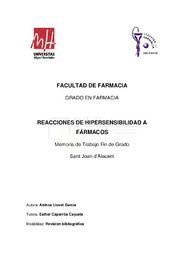Por favor, use este identificador para citar o enlazar este ítem:
https://hdl.handle.net/11000/31765Registro completo de metadatos
| Campo DC | Valor | Lengua/Idioma |
|---|---|---|
| dc.contributor.advisor | Caparrós Cayela, Esther | - |
| dc.contributor.author | Llovet García, Ainhoa | - |
| dc.contributor.other | Departamentos de la UMH::Medicina Clínica | es_ES |
| dc.date.accessioned | 2024-03-18T11:08:33Z | - |
| dc.date.available | 2024-03-18T11:08:33Z | - |
| dc.date.created | 2023-11-14 | - |
| dc.identifier.uri | https://hdl.handle.net/11000/31765 | - |
| dc.description.abstract | Las Reacciones de Hipersensibilidad a Medicamentos (RHM) suponen un gran problema a nivel sanitario. El saber distinguirlas y clasificarlas es un reto debido a los diversos mecanismos que pueden llegar a estar involucrados. Por otro lado, las pruebas diagnósticas existentes se encuentran basadas en un algoritmo que abarca la historia clínica del paciente, pruebas in vivo y pruebas in vitro. Esto se debe a que el diagnóstico es bastante complejo, y cada parte diagnóstica por separado no llega a ser del todo concluyente. Diversos estudios han demostrado que los grupos farmacológicos que más reacciones de hipersensibilidad producen son los AINES y los antibióticos β-lactámicos, ambos grupos son de los más utilizados hoy en día en la práctica clínica. En este TFG estudiaré los diversos tipos de RHM, tanto de su clasificación como de la participación del sistema inmunitario en cada una de ellas; al igual que estudiaré sus distintas pruebas diagnósticas. Adicionalmente, revisaré la actualización sobre los dos grupos farmacológicos que más reacciones de hipersensibilidad producen. | es_ES |
| dc.description.abstract | Drug Hypersensitivity Reactions (HSRs) are a major health problem. Knowing how to distinguish and classify them is a challenge due to the various mechanisms that may be involved. On the other hand, existing diagnostic tests are based on an algorithm that encompasses the patient's clinical history, in vivo tests and in vitro tests. This is because the diagnosis is quite complex, and each diagnostic part alone is not entirely conclusive. Several studies have shown that the pharmacological groups that produce the most hypersensitivity reactions are NSAIDs and β-lactam antibiotics, both of which are among the most commonly used in clinical practice today. In this dissertation I will study the different types of RHM, both their classification and the participation of the immune system in each of them, as well as the different diagnostic tests. In addition, the two pharmacological groups that produce the most hypersensitivity reactions will be presented. | es_ES |
| dc.format | application/pdf | es_ES |
| dc.format.extent | 33 | es_ES |
| dc.language.iso | spa | es_ES |
| dc.publisher | Universidad Miguel Hernández | es_ES |
| dc.rights | info:eu-repo/semantics/openAccess | es_ES |
| dc.rights | Attribution-NonCommercial-NoDerivatives 4.0 Internacional | * |
| dc.rights.uri | http://creativecommons.org/licenses/by-nc-nd/4.0/ | * |
| dc.subject | reacciones de hipersensibilidad | es_ES |
| dc.subject | clasificación reacciones de hipersensibilidad | es_ES |
| dc.subject | diagnóstico reacciones de hipersensibilidad | es_ES |
| dc.subject | antiinflamatorios no esteroideos | es_ES |
| dc.subject | antibióticos | es_ES |
| dc.subject | hipersensibilidad. | es_ES |
| dc.subject.other | CDU::6 - Ciencias aplicadas | es_ES |
| dc.title | Reacciones de hipersensibilidad a fármacos | es_ES |
| dc.type | info:eu-repo/semantics/bachelorThesis | es_ES |

Ver/Abrir:
TFG_AinhoaLlovet final.pdf
1,22 MB
Adobe PDF
Compartir:
 La licencia se describe como: Atribución-NonComercial-NoDerivada 4.0 Internacional.
La licencia se describe como: Atribución-NonComercial-NoDerivada 4.0 Internacional.
.png)